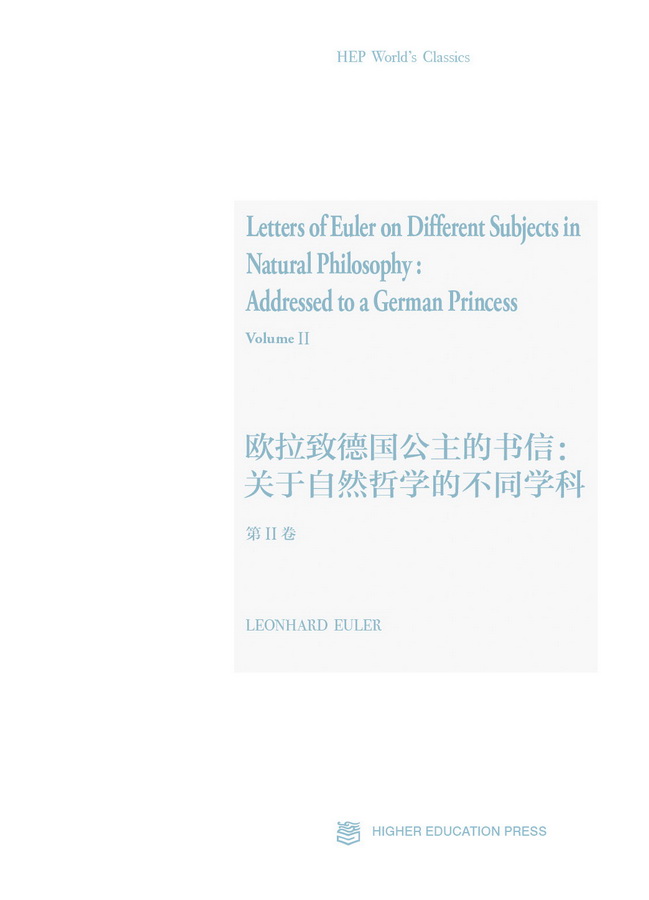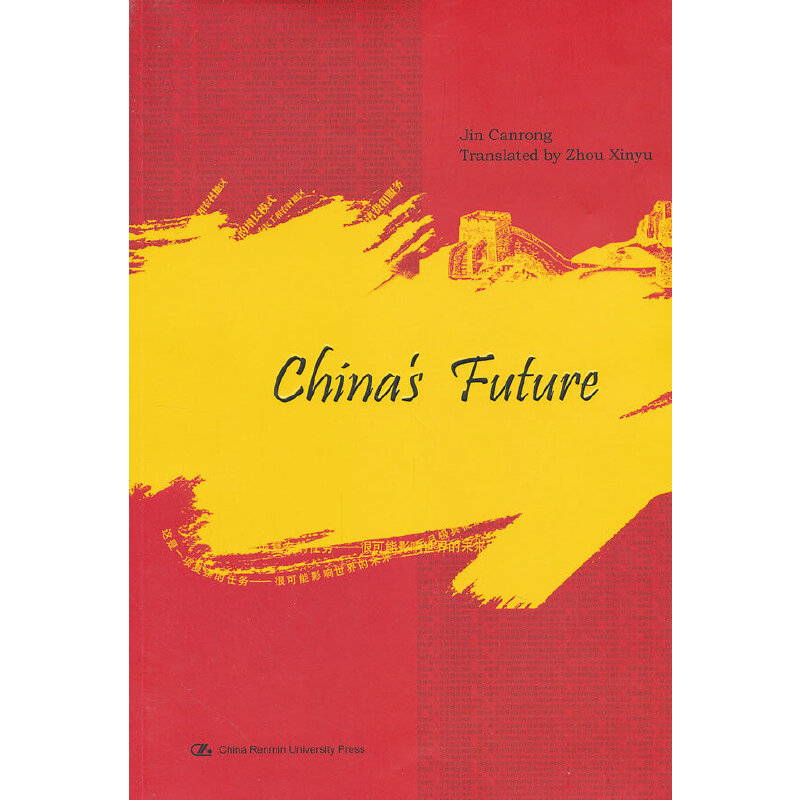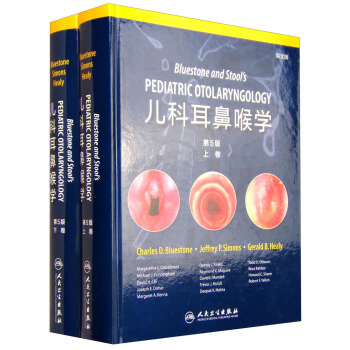欧拉致德国公主的书信:关于自然哲学的不同学科(第II卷)(英文版)
作者: Leonhard Euler
出版时间:2019-01
出版社:高等教育出版社
- 高等教育出版社
- 9787040510706
- 1版
- 239115
- 48266129-5
- 精装
- 16开
- 2019-01
- 296
- 296
- 数学类
- 研究生及以上
前辅文
LETTER I. Continuation of the Subject, and of Mistakes in the Knowledge of Truth.
LETTER II. First Class of Known Truths. Conviction That Things Exist Externally, Corresponding to the Ideas Represented by the Senses, Objection of the Pyrrhonists Reply.
LETTER III. Another Objection of the Pyrrhonists against the Certainty of Truths Perceived by the Senses. Reply; and Precautions for Attaining Assurance of Sensible Truths.
LETTER IV. Of Demonstrative, Physical, and Particularly of Moral Certainty.
LETTER V. Remarks that the Senses Contribute to the Increase of Knowledge; and Precautions for Acquiring the Certainty of Historical Truths.
LETTER VI. Whether the Essence of Bodies be Known by Us.
LETTER VII. The True Notion of Extension.
LETTER VIII. Divisibility of Extension in Infinitum.
LETTER IX. Whether This Divisibility in Infinitum Takes Place in Existing Bodies.
LETTER X. Of Monads.
LETTER XI. Reflections on Divisibility in Infinitum, and on Monads.
LETTER XII. Reply to the Objections of the Monadists to Divisibility in Infinitum.
LETTER XIII. Principle of the Sufficient Reason, the Strongest Support of the Monadists.
LETTER XIV. Another Argument of the Monadists, Derived from the Principle of the Sufficient Reason. Absurdities Resulting from It.
LETTER XV. Reflections on the System of Monads.
LETTER XVI. Continuation.
LETTER XVII. Conclusion of Reflections on This System.
LETTER XVIII. Elucidation Respecting the Nature of Colours.
LETTER XIX. Reflections on the Analogy between Colours and Sounds.
LETTER XX. Continuation.
LETTER XXI. How Opaque Bodies are Rendered Visible.
LETTER XXII. The Wonders of the Human Voice.
LETTER XXIII. A Summary of the Principal Phenomena of Electricity.
LETTER XXIV. The True Principle of Nature on Which Are Founded All the Phenomena of Electricity.
LETTER XXV. Continuation. Different Nature of Bodies Relatively to Electricity.
LETTER XXVI. On the Same Subject.
LETTER XXVII. Of Positive and Negative Electricity. Explanation of the Phenomenon of Attraction.
LETTER XXVIII. On the Same Subject.
LETTER XXIX. On the Electric Atmosphere.
LETTER XXX. Communication of Electricity to a Bar of Iron, by Means of a Globe of Glass.
LETTER XXXI. Electrization of Men and Animals.
LETTER XXXII. Distinctive Character of the Two Species of Electricity.
LETTER XXXIII. How the Same Globe of Glass May Furnish at Once the Two Species of Electricity.
LETTER XXXIV. The Leyden Experiment.
LETTER XXXV. Reflections on the Cause and Nature of Electricity, and on Other Means Proper to Produce It.
LETTER XXXVI. Nature of Thunder: Explanations of the Ancient Philosophers, and of Descartes: Resemblance of the Phenomena of Thunder to Those of Electricity.
LETTER XXXVII. Explanation of the Phenomena of Lightning and Thunder.
LETTER XXXVIII. Continuation.
LETTER XXXIX. The Possibility of Preventing, and of Averting, the Effects of Thunder.
LETTER XL. On the Celebrated Problem of the Longitude: General Description of the Earth, of Its Axis, Its Two Poles, and the Equator.
LETTER XLI. Of the Magnitude of the Earth; of Meridians, and the Shortest Road from Place to Place.
LETTER XLII. Of Latitude, and Its Influence on the Seasons, and the Length of the Day.
LETTER XLIII. Of Parallels, of the First Meridian, and of Longitude.
LETTER XLIV. Choice of the First Meridian.
LETTER XLV. Method of Determining the Latitude, or the Elevation of the Pole.
LETTER XLVI. Knowledge of the Longitude, from a Calculation of the Direction, and of the Space Passed through.
LETTER XLVII. Continuation. Defects of This Method.
LETTER XLVIII. Second Method of Determining the Longitude, by Means of an Exact Timepiece.
LETTER XLIX. Continuation, and Further Elucidations.
LETTER L. Eclipses of the Moon, a Third Method of Finding the Longitude.
LETTER LI. Observation of the Eclipses of the Satellites of Jupiter, a Fourth Method of Finding the Longitude.
LETTER LII. The Motion of the Moon, a Fifth Method.
LETTER LIII. Advantages of This Last Method; Its Degree of Precision.
LETTER LIV. On the Mariner's Compass, and the Properties of the Magnetic Needle.
LETTER LV. Declination of the Compass, and Manner of Observing It.
LETTER LVI. Difference in the Declination of the Compass at the Same Place.
LETTER LVII. Chart of Declinations; Method of Employing It for the Discovery of the Longitude.
LETTER LVIII. Why Does the Magnetic Needle Affect, in Every Place of the Earth, a Certain Direction, Differing in Different Places; and for What Reason Does It Change, with Time, at the Same Place?
LETTER LIX. Elucidations Respecting the Cause and Variation of the Declination of Magnetic Needles.
LETTER LX. Inclination or Dip of Magnetic Needles.
LETTER LXI. True Magnetic Direction; Subtile Matter Which Produces the Magnetic Power.
LETTER LXII. Nature of the Magnetic Matter, and of Its Rapid Current. Magnetic Canals.
LETTER LXIII. Magnetic Vortex. Action of Magnets upon Each Other.
LETTER LXIV. Nature of Iron and Steel. Method of Communicating to Them the Magnetic Force.
LETTER LXV. Action of Loadstones on Iron. Phenomena Observable on Placing Pieces of Iron near a Loadstone.
LETTER LXVI. Arming of Loadstones.
LETTER LXVII. Action and Force of Armed Loadstones.
LETTER LXVIII. The Method of Communicating to Steel the Magnetic Force, and of Magnetizing Needles for the Compass: the Simple Touch, Its Defects; Means of Remedying These.
LETTER LXIX. On the Double Touch. Means of Preserving the Magnetic Matter in Magnetized Bars.
LETTER LXX. The Method of Communicating to Bars of Steel a Very Great Magnetic Force, by Means of Other Bars Which Have It in a Very Inferior Degree.
LETTER LXXI. Construction of Artificial Magnets in the Form of a Horse-shoe.
LETTER LXXII. On Dioptrics; Instruments Which That Science Supplies: of Telescopes and Microscopes. Different Figures Given to Glasses or Lenses.
LETTER LXXIII. Difference of Lenses with Respect to the Curve of Their Surfaces. Distribution of Lenses into Three Classes.
LETTER LXXIV. Effect of Convex Lenses.
LETTER LXXV. The Same Subject: Distance of the Focus of Convex Lenses.
LETTER LXXVI. Distance of the Image of Objects.
LETTER LXXVII. Magnitude of Images.
LETTER LXXVIII. Burning-glasses.
LETTER LXXIX. The Camera Obscura.
LETTER LXXX. Reflections on the Representation in the Camera Obscura.
LETTER LXXXI. Of the Magic Lantern, and Solar Microscope.
LETTER LXXXII. Use and Effect of a Simple Convex Lens.
LETTER LXXXIII. Use and Effect of a Concave Lens.
LETTER LXXXIV. Of Apparent Magnitude, of the Visual Angle, and of Microscopes in General.
LETTER LXXXV. Estimation of the Magnitude of Objects Viewed through the Microscope.
LETTER LXXXVI. Fundamental Proposition for the Construction of Simple Microscopes. Plan of Some Simple Microscopes.
LETTER LXXXVII. Limits and Defects of the Simple Microscope.
LETTER LXXXVIII. On Telescopes, and Their Effect.
LETTER LXXXIX. Of Pocket-glasses.
LETTER XC. On the Magnifying Power of Pocket-glasses.
LETTER XCI. Defects of Pocket-glasses. Of the Apparent Field.
LETTER XCII. Determination of the Apparent Field for Pocket-glasses.
LETTER XCIII. Astronomical Telescopes, and Their Magnifying Power.
LETTER XCIV. Of the Apparent Field, and the Place of the Eye.
LETTER XCV. Determination of the Magnifying Power of Astronomical Telescopes, and the Construction of a Telescope Which Shall Magnify Objects a Given Number of Times.
LETTER XCVI. Degree of Clearness.
LETTER XCVII. Aperture of Object-glasses.
LETTER XCVIII. On Distinctness in the Expression: On the Space of Diffusion Occasioned by the Aperture of Object-glasses, and Considered as the First Source of Want of Distinctness in the Representation.
LETTER XCIX. Diminution of the Aperture of Lenses, and Other Means of Lessening the Space of Diffusion Till It Is Reduced to Nothing.
LETTER C. Of Compound Object-glasses.
LETTER CI Formation of Simple Object-glasses.
LETTER CII. Second Source of Defect as to Distinctness of Representation by the Telescope. Different Refrangibility of Rays.
LETTER CIII. Means of Remedying This Defect by Compound Object-glasses.
LETTER CIV. Other Means More Practicable.
LETTER CV. Recapitulation of the Qualities of a Good Telescope.
LETTER CVI. Terrestrial Telescopes with Four Lenses.
LETTER CVII. Arrangement of Lenses in Terrestrial Telescopes.
LETTER CVIII. Precautions to Be Observed in the Construction of Telescopes. Necessity of Blackening the Inside of Tubes. Diaphragms.
LETTER CIX. In What Manner Telescopes Represent the Moon, the Planets, the Sun, and the Fixed Stars. Why These Last Appear Smaller through the Telescope than to the Naked Eye. Calculation of the Distance of the Fixed Stars, from a Comparison of Their Apparent Magnitude with That of the Sun.
LETTER CX. Why Do the Moon and the Sun Appear Greater at Rising and Setting than at a Certain Elevation? Difficulties Attending the Solution of This Phenomenon.
LETTER CXI. Reflections on the Question Respecting the Moon's Apparent Magnitude. Progress towards a Solution of the Difficulty. Absurd Explanations.
LETTER CXII. An Attempt towards the True Explanation of This Phenomenon\,---\,The Moon Appears More Distant When in the Horizon than When at a Great Elevation.
LETTER CXIII. The Heavens Appear under the Form of an Arch Flattened towards the Zenith.
LETTER CXIV. Reason Assigned for the Faintness of the Light of the Heavenly Bodies in the Horizon.
LETTER CXV. Illusion Respecting the Distance of Objects, and the Diminution of Lustre.
LETTER CXVI. On the Azure Colour of the Heavens.
LETTER CXVII. What the Appearance Would Be Were the Air Perfectly Transparent.
LETTER CXVIII. Refraction of Rays of Light in the Atmosphere, and Its Effects. Of the Twilight. Of the Apparent Rising and Setting of the Heavenly Bodies.
LETTER CXIX. The Stars Appear at a Greater Elevation than They Are. Table of Refractions.
GLOSSARY










